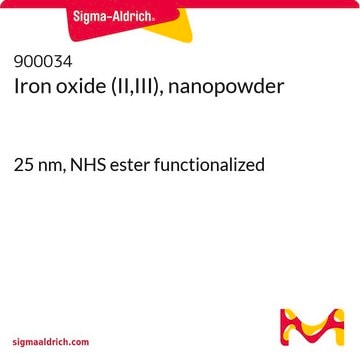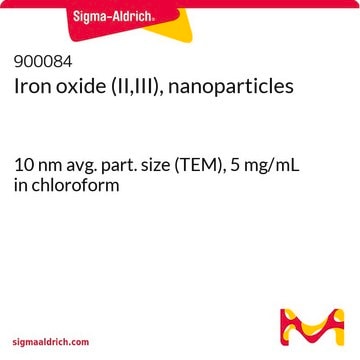All Photos(1)
About This Item
Empirical Formula (Hill Notation):
Fe3O4
CAS Number:
Molecular Weight:
231.53
EC Number:
MDL number:
UNSPSC Code:
12352300
PubChem Substance ID:
Recommended Products
grade
CP
form
powder
availability
available only in Japan
mp
1538 °C (lit.)
density
4.8-5.1 g/mL at 25 °C (lit.)
SMILES string
O=[Fe].O=[Fe]O[Fe]=O
InChI
1S/3Fe.4O
InChI key
SZVJSHCCFOBDDC-UHFFFAOYSA-N
Looking for similar products? Visit Product Comparison Guide
Storage Class Code
11 - Combustible Solids
WGK
nwg
Flash Point(F)
Not applicable
Flash Point(C)
Not applicable
Personal Protective Equipment
dust mask type N95 (US), Eyeshields, Gloves
Certificates of Analysis (COA)
Search for Certificates of Analysis (COA) by entering the products Lot/Batch Number. Lot and Batch Numbers can be found on a product’s label following the words ‘Lot’ or ‘Batch’.
Already Own This Product?
Find documentation for the products that you have recently purchased in the Document Library.
Yongxing Hu et al.
Journal of the American Chemical Society, 135(6), 2213-2221 (2013-01-26)
Controlled assembly of nanoparticles into asymmetric configurations is of great interest due to their novel properties and promising applications. In this Article, we report a generic strategy for the synthesis of dimer nanoclusters and asymmetric nanoassemblies by using magnetic colloidal
Jens Baumgartner et al.
Nature materials, 12(4), 310-314 (2013-02-05)
The formation of crystalline materials from solution is usually described by the nucleation and growth theory, where atoms or molecules are assumed to assemble directly from solution. For numerous systems, the formation of the thermodynamically stable crystalline phase is additionally
Marina I Siponen et al.
Nature, 502(7473), 681-684 (2013-10-08)
Magnetotactic bacteria align along the Earth's magnetic field using an organelle called the magnetosome, a biomineralized magnetite (Fe(II)Fe(III)2O4) or greigite (Fe(II)Fe(III)2S4) crystal embedded in a lipid vesicle. Although the need for both iron(II) and iron(III) is clear, little is known
A Aranda et al.
Toxicology in vitro : an international journal published in association with BIBRA, 27(2), 954-963 (2013-01-30)
No consensus exists on how to address possible toxicity of nanomaterials as they interfere with most in vitro screening tests based on colorimetric and fluorimetric probes such as the dichloro-dihydro-fluorescein diacetate (DCFH-DA) assay for detection of oxidative species. In the
Leyong Zeng et al.
Nanoscale, 5(5), 2107-2113 (2013-02-06)
Multifunctional Fe(3)O(4)-TiO(2) nanocomposites with Janus structure for magnetic resonance imaging (MRI) and potential photodynamic therapy (PDT) were synthesized, in which Fe(3)O(4) was used as a MRI contrast agent and TiO(2) as an inorganic photosensitizer for PDT. Their morphology, structure, and
Our team of scientists has experience in all areas of research including Life Science, Material Science, Chemical Synthesis, Chromatography, Analytical and many others.
Contact Technical Service






